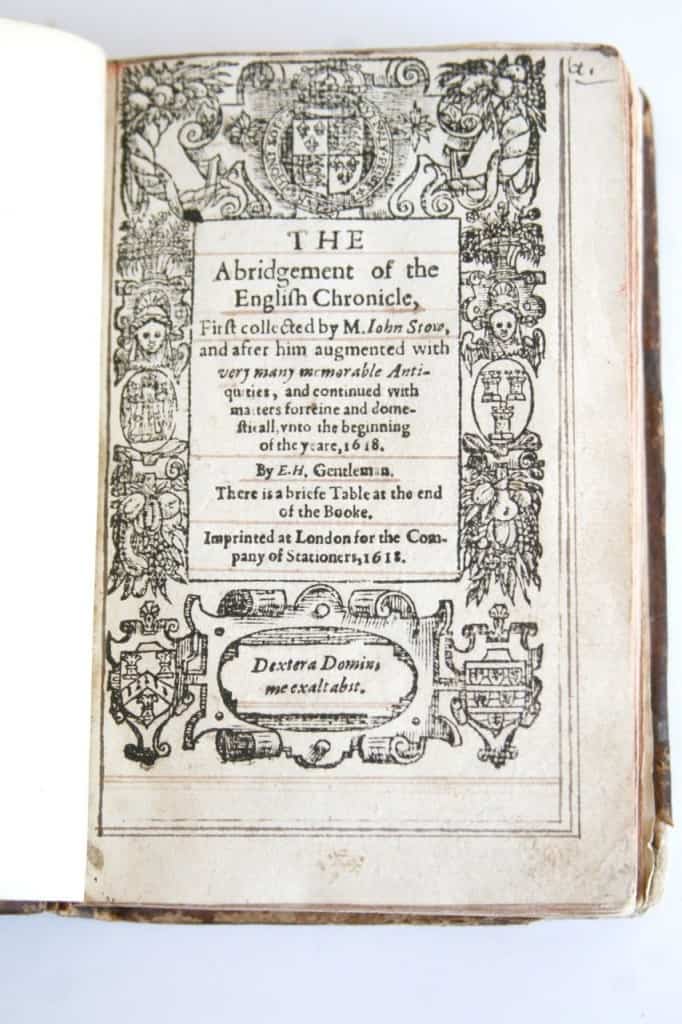October 10, 2011
VERY RARE 1618 COPY OF JOHN STOW’S CHRONICLE
STOW’S CHRONICLE WAS ONE OF THE MOST IMPORTANT ELIZABETHAN SOURCE BOOKS
BURNING OF WITCHES,
WILLIAM SHAKESPEARE,
DISCOVERY AND COLONIZATION OF VIRGINIA
The Book:
John Stow; (edited and continued by) Edmund Howes . The abridgement of the English chronicle : first collected by M. John Stow, and after him augmented with very many memorable antiquities, and continued with matters forreine and domesticall, vnto the beginning of the yeare, 1618. London : [By Edward Allde and Nicholas Okes], 1618. COMPLETE. [11 of 12, lacking only blank A8 as in Macclesfield copy], 568 [i.e. 564 (due to page numeration error), 16] p. ; 8vo, 16cm., Page numeration errors (but no missing leaves); p. 465-466 and 487-488 are mis-numbered. Printers’ names, not explicit on t.p., taken from STC. Early calf worn as depicted, boards partially separated, some toning, later endpapers, occasional worming, ample title page margins with hand drawn borders, a page of the table re-margined with no loss, interesting marginalia including a 4 line poem on the lower margin of 242, presumably referring to King Henry VIII and employing similar phrasing to Macbeth with “hath no end”. Occasional signatures of early owners on 2 leaves , later provenance of Charles Frederick Tootal. A 17th century hand rightfully notes “thus far Stow” on p. 436, indicating the continuation of the Chronicle by Howes. VERY RARE. All of Stow’s and Howe’s early Chronicles are rare; they were very popular and often read to shreds, accounting for the poor condition of surviving copies. THE ABPC lists only two copies of the 1618 at auction in 30 years; the last, the Macclesfield copy described as “Lacking blank A8; blank A1 becoming detached; a few small tears with marginal loss” and a second copy in poorer shape than the present listed as “rebacked, rubbed – Dampstained throughout; some foxing & soiling.” [SOLD]
This is Howe’s continuation of Stow’s famous Elizabethan Chronicle. It was issued in several editions, starting in 1610, each adding to the previous to keep it up-to-date. Howe evidently labored five years on its preparation, compiling important source material firsthand including a list of all the principle fairs held throughout England and Wales (appended). This edition is of particular interest to Shakespeare scholars as it recounts the burning of the famous Globe Theatre in 1613, noted for its performances by Shakespeare and his associates. Additionally, it provides important Shakespearean literary references and background information. For instance, in the Winter’s Tale, where we hear of “Gloves as sweet as damask roses,” Howes offers some insightful historical context to perfumed gloves. He states (spelling partly altered) that the English could not ” make any costly wash or perfume, until about the fourteenth or fifteenth of the Queen [Elizabeth] the right honourable Earle of Oxford came from Italy, and brought with him gloves, sweet bagges, a perfumed leather jerkin, and other pleasant things: and that year the Queen had a pair of perfumed gloves trimmed with foure tuftes, or roses, of cullered silke. The queene took such pleasure in those gloves, that she was pictured with those gloves upon her hands: and for many years after it was called the Earle of Oxford’s perfume.
The rest of the work is likewise filled with fascinating historical tidbits from tales of Burnt Witches (p. 172), to when Queen Elizabeth I granted Sir Walter Raleigh a charter for the colonization of the area of North America known as Virginia (p. 512)


